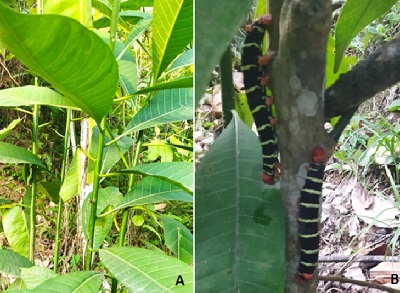Control biológico natural de larvas de Pseudosphinx tetrio con Bacillus thuringiensis en plantas de Himatanthus sucuuba en Satipo
DOI:
https://doi.org/10.55873/rba.v3i1.272Palabras clave:
bacteria, control, larva, mortalidad, rebroteResumen
El objetivo del estudio fue evaluar el control biológico natural de orugas Pseudosphinx tetrio en condiciones de campo. La investigación se realizó entre febrero y marzo a una altitud de 670 msnm. Se observaron larvas en seis árboles en rebrote con 6 a 10 ejes de 2 a 3 m de altura y abundancia de hoja; se evaluó in situ el número de larvas muertas por la bacteria. Los resultados mostraron un promedio de 15,83 + 5,27 larvas del último estadio por planta; 13,67 + 4,89 larvas muertas y 85,9 + 4.67% de control biológico natural de B. thuringensis sobre larvas de P. tetrio. El control biológico de la larva se produce en el último estadio, momento en que la bacteria hace efecto causando una alta mortalidad, donde la larva enferma se cuelga de una hoja de la misma planta, luego se adelgaza, se oscurece y muere cayendoa
Citas
Arsov, A., Gerginova, M., Paunova-Krasteva, T., Petrov, K., & Petrova, P. (2023). Multiple
genes in Bacillus thuringiensis strain BTG suggest a broad-spectrum insecticidal activity. International Journal of Molecular Sciences, 24(13), 11137. https://doi.org/10.3390/ijms241311137
Baranek, J., Pluskota, M., Rusin, M. et al. Insecticidal activity of Bacillus thuringiensis strains isolated from tropical greenhouses towards Cydia pomonella and Spodoptera exigua larvae. BioControl 68, 39–48 (2023). https://doi.org/10.1007/s10526-022-10173-3
Belousova, M. E., Malovichko, Y. V., Shikov, A. E., Nizhnikov, A. A., & Antonets, K. S. (2021). Dissecting the environmental consequences of Bacillus thuringiensis application for natural ecosystems. Toxins, 13(5), 355.
https://doi.org/10.3390/toxins13050355
Calero-Armijos, L. L., Herrera-Calderon, O., Arroyo-Acevedo, J. L., Rojas-Armas, J. P., Hañari-Quispe, R. D., & Figueroa-Salvador, L. (2020). Histopathological evaluation of latex of Bellaco-Caspi, Himatanthus sucuuba (Spruce) Woodson on wound healing effect in BALB/C mice. Veterinary World, 13(6), 1045. https://www.ncbi.nlm.nih.gov/pmc/articles/PMC7396333/
Chandrakasan, G., Ayala, M. T., Trejo, J. F. G., Marcus, G., Maruthupandy, M., Kanisha, C. C., ... & Wadaan, M. A. (2022). Bio controlled efficacy of Bacillus thuringiensis cry protein protection against tomato fruit borer Helicoverpa armigera in a laboratory environment. Physiological and Molecular Plant Pathology, 119, 101827. https://doi.org/10.1016/j.pmpp.2022.101827
Cock, M.J.W. 2008. Pseudosphinx tetrio (L.) (Lepidoptera: Sphingidae) in Trinidad and Tobago. Living World, Journal of The Trinidad and Tobago Field Naturalists’ Club, 2008, 49-52. http://www.livingworld.ttfnc.org/index.php/lwj/article/view/cock2008c/339
Conde Miranda, J. R. (2011). Efecto de entomopatógenos en el control de Erinnyis ello,(Lepidoptera: Sphingidae) en cultivo de yuca (Manihot esculenta C.) en el municippio de Palos Blancos, departamento de La Paz (Doctoral dissertation). http://repositorio.umsa.bo/xmlui/handle/123456789/7234
Domínguez-Arrizabalaga, M., Villanueva, M., Escriche, B., Ancín-Azpilicueta, C., & Caballero, P. (2020). https://doi.org/10.3390/toxins12070430
Duarte Neto, J. M. W., Wanderley, M. C. D. A., da Silva, T. A. F., Marques, D. A. V., da Silva, G. R., Gurgel, J. F., ... & Porto, A. L. F. (2020). Bacillus thuringiensis endotoxin production: a systematic review of the past 10 years. World Journal of Microbiology and Biotechnology, 36, 1-21. https://link.springer.com/article/10.1007/s11274-020-02904-4
Elsharkawy, M. M., Almasoud, M., Alsulaiman, Y. M., Baeshen, R. S., Elshazly, H., Kadi, R. H., ... & Shawer, R. (2022). Efficiency of Bacillus thuringiensis and Bacillus cereus against Rhynchophorus ferrugineus. Insects, 13(10), 905.
https://doi.org/10.3390/insects13100905
Matignon, L., Lo, M. E. M., Vicentini, M., Valencia, D. P., Palmeira-Mello, M. V., Sylvestre, M., ... & Cebrián-Torrejón, G. (2021). Chemoecological Study of Trophic Interaction Between Pseudosphinx Tetrio L. Larvae and Allamanda Cathartica L. https://doi.org/10.21203/rs.3.rs-776886/v1
Minno M. C., Darrow H. N. (1995). Pseudosphinx tetrio (Lepidoptera, Sphingidae) in the Florida Keys. Journal article: News of the Lepidopterists' Society, 1995, No. No. 1, 6 ref. 2
https://www.cabidigitallibrary.org/doi/full/10.5555/19951107083
Nutaratat, P., Werapan, B., Phosrithong, N., Trakulnaleamsai, C., Rungrod, A., Utamatho, M., ... & Prathumpai, W. (2023). Vegetative insecticidal protein (Vip3A) production by Bacillus thuringiensis Bt294 and its efficacy against Lepidopteran pests (Spodoptera exigua). Biotechnology Reports, 40, e00812. https://doi.org/10.1016/j.btre.2023.e00812
Park, M. G., Choi, J. Y., Kim, J. H., Park, D. H., Wang, M., Kim, H. J., ... & Je, Y. H. (2022). Isolation and molecular characterization of Bacillus thuringiensis subsp. kurstaki toxic to lepidopteran pests Spodoptera spp. and Plutella xylostella. Pest management science, 78(7), 2976-2984.
https://doi.org/10.1002/ps.6922
Pinos, D., Andrés-Garrido, A., Ferré, J., & Hernández-Martínez, P. (2021). Response mechanisms of invertebrates to Bacillus thuringiensis and its pesticidal proteins. Microbiology and Molecular Biology Reviews, 85(1), 10-1128. https://doi.org/10.1128/mmbr.00007-20
Santiago-Blay J. A. (1987). Notes on Pseudosphinx tetrio (L.) (Sphingidae) in Puerto Rico. Journal article: Journal of the Lepidopterists' Society, 1985, publ. 1986, Vol. 39, No. 3, 208-214 ref. 14. https://www.cabidigitallibrary.org/doi/full/10.5555/19870542923
Squyres S. (2024). La oruga frangipani tropical, Pseudosphinx tetrio, puede crecer hasta 6 pulgadas de largo. Medicina ambiental y silvestre. 2014;25(1):127-128. doi: www.http//10.1016/j.wem.2013.09.015
Vázquez-Ramírez, M. F., Rangel-Núñez, J. C., Ibarra, J. E., & Del Rincón-Castro, M. C. (2015). Evaluación como agentes de control biológico y caracterización de cepas mexicanas de Bacillus thuringiensis contra el gusano cogollero del maíz Spodoptera frugiperda (Lepidotera: Noctuidae). Interciencia, 40(6), 397-402. https://www.redalyc.org/articulo.oa?id=33938675006
Wei, J. Z., Lum, A., Schepers, E., Liu, L., Weston, R. T., McGinness, B. S., ... & Anderson, M. A. (2023). Novel insecticidal proteins from ferns resemble insecticidal proteins from Bacillus thuringiensis. Proceedings of the National Academy of Sciences, 120(44), e2306177120.
https://doi.org/10.1073/pnas.2306177120
Yamamoto, T. (2022). Engineering of Bacillus thuringiensis insecticidal proteins. Journal of Pesticide Science, 47(2), 47-58. https://www.jstage.jst.go.jp/article/jpestics/47/2/47_D22-016/_article/-char/ja/

Descargas
Publicado
Cómo citar
Número
Sección
Licencia
Derechos de autor 2024 José Manuel Alomía-Lucero, Milcíades Aníbal Baltazar-Ruiz , Miriam Dacia Cañari-Contreras, Hebert Nino Estrada-Carhuallanqui , Angélica Castro-Garay

Esta obra está bajo una licencia internacional Creative Commons Atribución 4.0.







